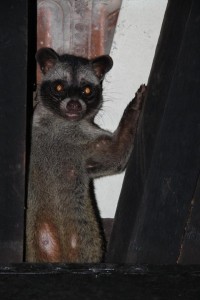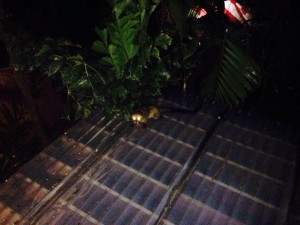Perhaps, since our homeland is turning 50 today, it is a good time to look back on where we have come so far in the last five years of research on and outreach efforts for the common palm civets of Singapore. As Singapore celebrates her golden jubilee, we recognize and appreciate the growth and development that this country has been through since its independence.
It is heartwarming to know that despite the extensive efforts to advance into a more urban landscape, our late former Prime Minister, Mr Lee Kuan Yew, did not disregard the importance of having a good proportion of green in our environment too. In 1963, he planted a Mempat tree in Farrer Circus to kickstart the greening campaign of Singapore. This increase in greenery has led to more experiences with our local wildlife, which we are always striving to understand more about. In our case, it’s the common palm civets.
Our civet research work officially started in 2009, when Weiting devoted her honours thesis to better understand the growing human-civet conflict in the Siglap/Opera estate area. As a result of her study, we were able to learn how the civets have managed to adapt to urban landscapes and live amongst humans. A year later, Tze Kwan began her study to identify some key elements of the civet’s diet through the analysis of their poop, which allowed us to have a better understanding of the effect of the digestive process of their gut on seed germination and the role that civets play in urban landscapes.
The research findings have also allowed us to share with many other people, adults and children alike, more about the civets. Many of whom are surprised to find that the civets not only exist in Singapore, but are also native to the country and many parts of Southeast Asia too. Besides people, the knowledge gained has also helped civets (both locally and regionally), be it babies in need of rescue or those in conflict with humans. The support and encouragement that we receive for the work that we do have been great, and in turn we have been provided avenues to conduct educational walks, talks, and present at roadshow booths. Not only have we managed to educate, but we’ve also inspired, encouraging those that we speak to to be kind to our native civets.
Many have also come forward to share their sightings and civet encounters with us, which we are always enthused to hear about. Here are just some of our favourites:
 This was shared with us two months ago by Craig Williams, who was lucky enough to spot one of these elusive creatures during his night walk.
This was shared with us two months ago by Craig Williams, who was lucky enough to spot one of these elusive creatures during his night walk.
A civet spotted by Aaron Keddie, just outside his bedroom window! Civets are extremely shy creatures, so they’ll be more surprised than you are if you manage to catch them off guard!
 Clare Haxby shared this photo of an adorable civet hiding in her house 2 years ago. The civet was lactating then, and the babies she had then are most probably full-grown civets now.
Clare Haxby shared this photo of an adorable civet hiding in her house 2 years ago. The civet was lactating then, and the babies she had then are most probably full-grown civets now.

This is a baby civet that was found back in 2013 by Sally Cashman. It had fallen out of its nest on Christmas Eve, and if not for Sally’s effort and care, it wouldn’t have been able to reunite with its family the very next day.
Evidently, the existence of the civet as one of Singapore’s last wild urban carnivores has been celebrated by many, though not all. And even today the civets still face a fair amount of hostility from the human residents that they encounter based on the number of traps that they innocently wander into. While traps are commonly used to remove unwanted pests from the home, they are also a direct threat to our local wildlife and should not be encouraged.
Read more about the dangers of trapping in our next post. In the meantime, have a great jubilee weekend. Happy birthday Singapore, and a wonderful National Day to everyone!



